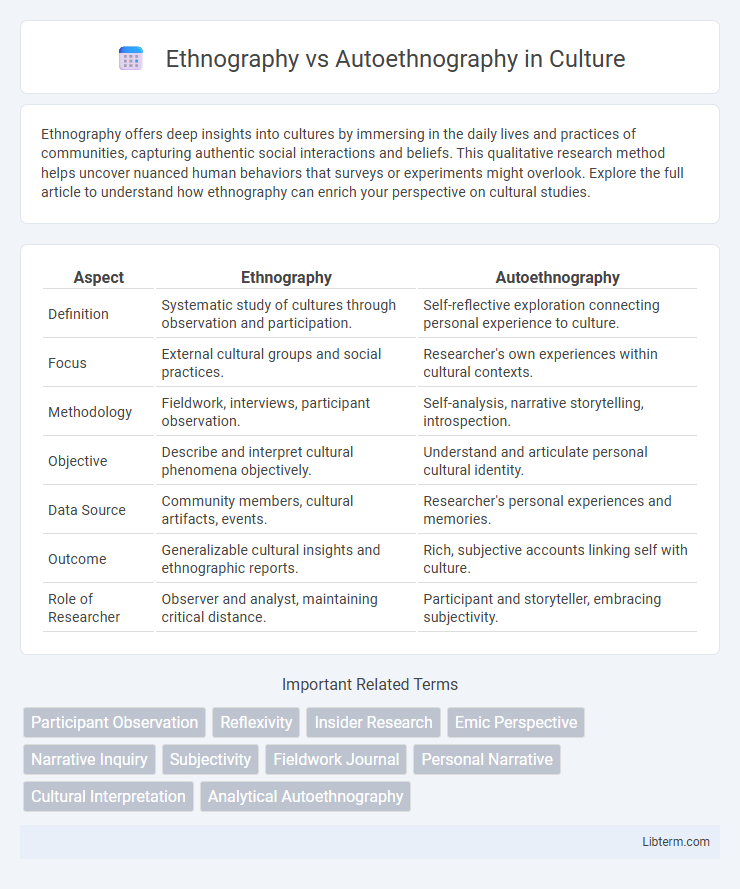Ethnography offers deep insights into cultures by immersing in the daily lives and practices of communities, capturing authentic social interactions and beliefs. This qualitative research method helps uncover nuanced human behaviors that surveys or experiments might overlook. Explore the full article to understand how ethnography can enrich your perspective on cultural studies.
Table of Comparison
| Aspect | Ethnography | Autoethnography |
|---|---|---|
| Definition | Systematic study of cultures through observation and participation. | Self-reflective exploration connecting personal experience to culture. |
| Focus | External cultural groups and social practices. | Researcher's own experiences within cultural contexts. |
| Methodology | Fieldwork, interviews, participant observation. | Self-analysis, narrative storytelling, introspection. |
| Objective | Describe and interpret cultural phenomena objectively. | Understand and articulate personal cultural identity. |
| Data Source | Community members, cultural artifacts, events. | Researcher's personal experiences and memories. |
| Outcome | Generalizable cultural insights and ethnographic reports. | Rich, subjective accounts linking self with culture. |
| Role of Researcher | Observer and analyst, maintaining critical distance. | Participant and storyteller, embracing subjectivity. |
Introduction to Ethnography and Autoethnography
Ethnography involves the systematic study of cultures and communities through immersive observation and detailed fieldwork, emphasizing the researcher's role as an external observer to document social practices and behaviors. Autoethnography, in contrast, merges autobiography with ethnographic methods, where researchers use self-reflection and personal experience as primary data to explore cultural phenomena. Both methods prioritize qualitative insights but differ in perspective, with ethnography focusing on external cultural contexts, while autoethnography centers on the internal, subjective experience of the researcher within that culture.
Defining Ethnography
Ethnography is a qualitative research method centered on systematically studying cultures and social interactions through immersive observation and detailed fieldwork. It aims to understand behaviors, rituals, and social norms by engaging with participants within their natural environments. This approach contrasts with autoethnography, which emphasizes self-reflection and personal experience as a primary data source.
Key Features of Autoethnography
Autoethnography integrates personal experience with cultural analysis, emphasizing reflexivity, emotional engagement, and narrative storytelling to connect individual stories to broader social contexts. It prioritizes subjectivity and researcher introspection, contrasting with traditional ethnography's focus on observing others externally. Key features include a first-person perspective, the blending of autobiography and ethnographic research, and an emphasis on socio-cultural critique through self-reflection.
Methodological Differences
Ethnography emphasizes immersive observation and interaction within a community to understand cultural practices from an outsider's perspective, relying on extensive field notes and interviews. Autoethnography combines personal narrative with cultural analysis, positioning the researcher's own experiences as primary data to explore broader social phenomena. Methodologically, ethnography seeks objective cultural insights through systematic fieldwork, while autoethnography prioritizes subjective reflection and meaning-making within the context of individual identity and culture.
Role of Researcher in Each Approach
In ethnography, the researcher maintains an external, observational role to objectively study cultural groups, often immersing themselves in the community to gather data. Autoethnography positions the researcher as both participant and analyst, using personal experience to critically examine and interpret cultural phenomena. The dual role in autoethnography enables a reflexive approach, blending subjective insight with cultural analysis.
Data Collection and Analysis Techniques
Ethnography employs participant observation, interviews, and field notes to collect data, emphasizing immersive cultural contexts and systematic coding for thematic analysis. Autoethnography relies on self-reflection, personal narratives, and journals, using introspective analysis to connect individual experiences with broader cultural meanings. Both methods analyze qualitative data but differ in the balance between external observation and internal subjectivity.
Strengths and Limitations
Ethnography provides a comprehensive understanding of cultural groups through systematic observation and participation, offering rich, contextualized data but often requires significant time and may risk researcher bias from outsider perspectives. Autoethnography leverages personal experience to reveal cultural insights, fostering deep emotional connection and reflexivity, yet it may face limitations in generalizability and be criticized for subjectivity. Balancing ethnographic objectivity with autoethnographic introspection enhances qualitative research by combining broad cultural analysis with individual narrative depth.
Ethical Considerations
Ethnography involves researchers maintaining an objective distance to study cultures ethically, requiring informed consent and protecting participant anonymity. Autoethnography presents unique ethical challenges as researchers analyze their own experiences, necessitating heightened reflexivity and transparency about personal biases. Both methodologies demand rigorous attention to confidentiality and respect for participants to uphold ethical research standards.
Applications in Academic Research
Ethnography in academic research involves immersive fieldwork to systematically observe and analyze cultural practices within a community, providing rich contextual data for disciplines like anthropology and sociology. Autoethnography, by contrast, emphasizes the researcher's personal experience and reflexivity, offering nuanced insights into identity, emotions, and social phenomena often used in qualitative studies across education, health, and communication fields. Both methods contribute uniquely to understanding human behavior, with ethnography focusing on collective cultural patterns and autoethnography highlighting subjective narratives and self-exploration.
Choosing the Right Approach for Your Study
Ethnography involves immersive observation and interaction to understand cultural practices within a community, ideal for studying groups or social settings externally. Autoethnography centers on the researcher's personal experience and introspective analysis, suitable when exploring identity, emotions, or self-reflection related to cultural phenomena. Selecting the right approach depends on whether the study aims to reveal collective cultural patterns through detached observation or deep personal narrative to uncover subjective insights.
Ethnography Infographic

 libterm.com
libterm.com